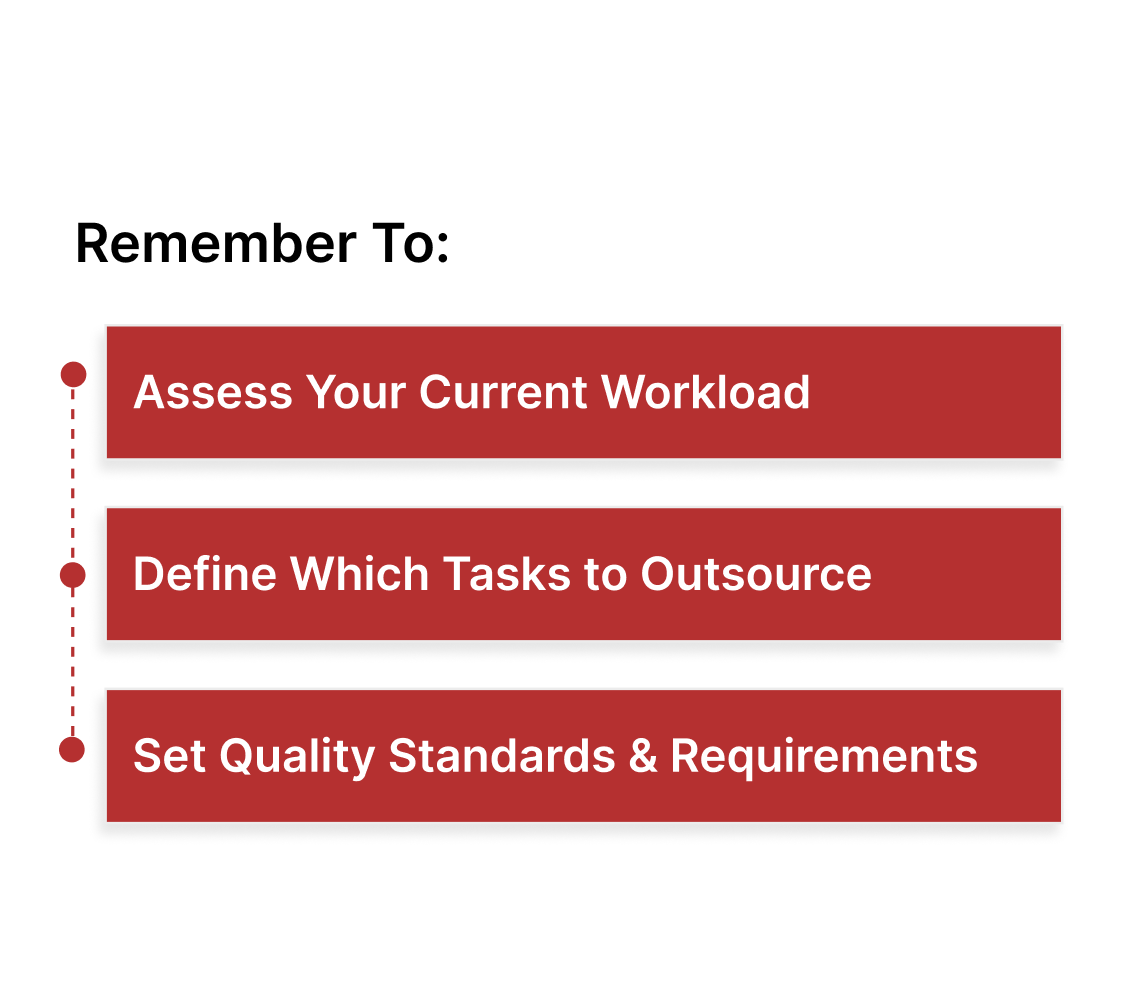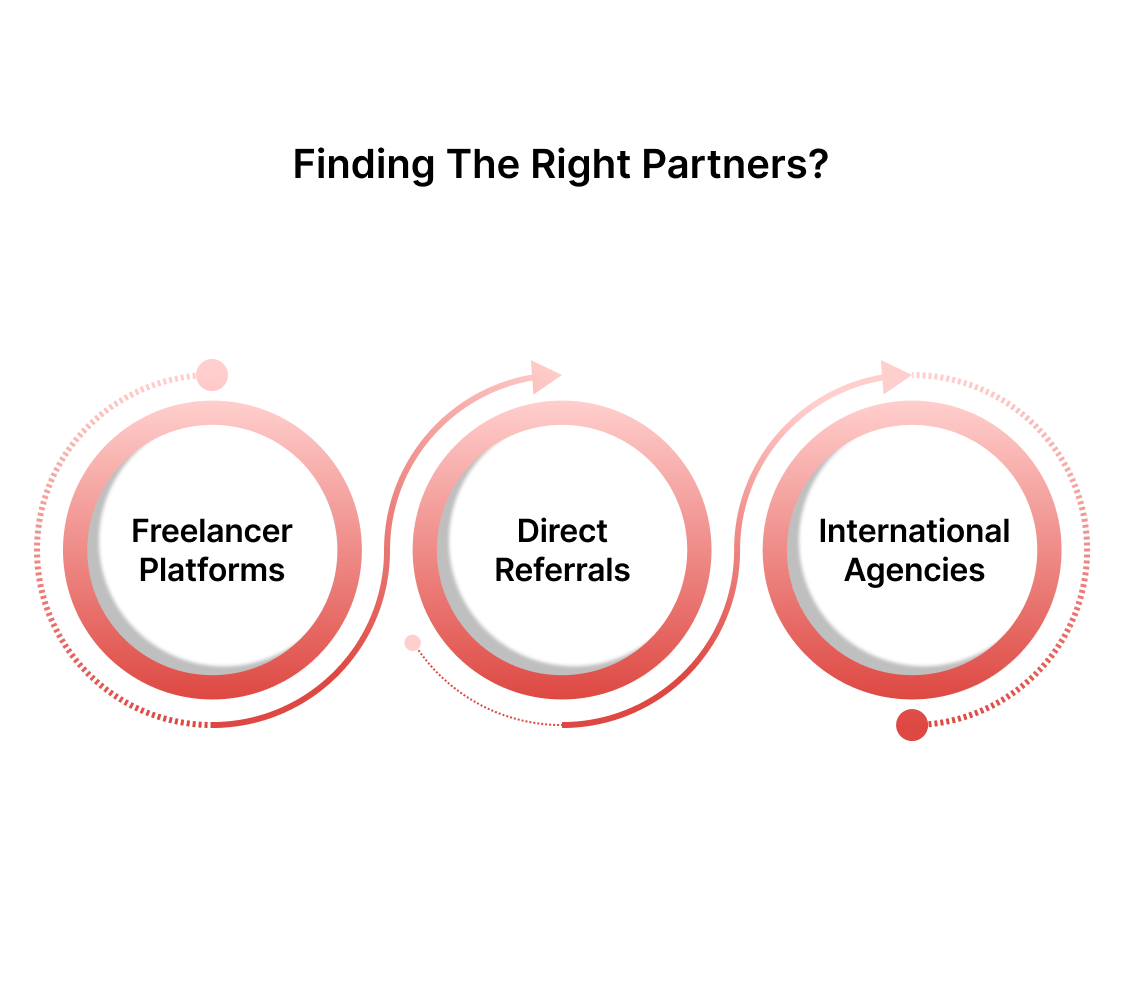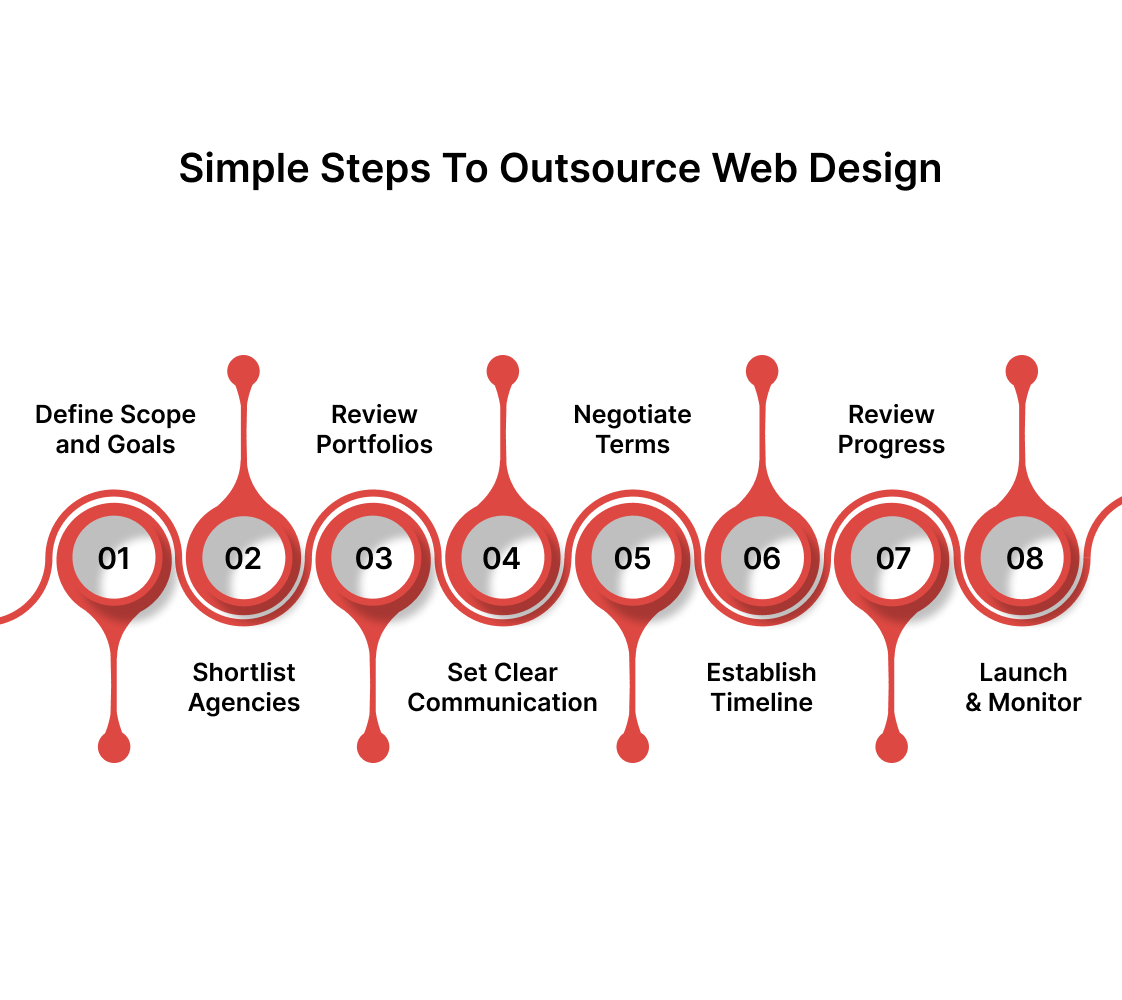Running a web design agency means juggling client demands, tight deadlines, and resource constraints. You want to deliver stellar websites without burning out your team or breaking budgets.
Outsourcing web design work can be your lifeline – giving you access to skilled talent, faster turnaround times, and the ability to take on more projects.
But finding reliable partners who understand your standards and won't disappoint clients? That's the real challenge. The right outsourcing strategy lets you scale smart, maintain quality, and actually enjoy running your business again.
Key Takeaways for Busy Readers
- Start with capacity analysis - Document your workload gaps and busy periods before outsourcing to identify exactly what tasks need external support.
- Quality standards prevent disasters - Create detailed checklists and project briefs upfront rather than hoping partners will guess your expectations correctly.
- Test before committing big - Run small paid projects with potential partners to evaluate their communication, quality, and reliability before major collaborations.
- Communication trumps cost savings - Choose partners based on responsiveness and clarity over the lowest price to avoid project delays and client disappointment.
- Keep client-facing work internal - Outsource technical tasks like coding and asset preparation while maintaining strategy sessions and quality control in-house.
Before You Outsource, Remember To:

Alt text : Before You Outsource, Remember To
1. Assess Your Current Workload and Capacity Gaps
Start by taking an honest look at your agency's current situation. Track how much time your team spends on different types of projects over a typical month. Are you consistently turning down new clients because you're at capacity?
Do certain team members work overtime regularly, while others have lighter loads?
Document your busiest periods and identify patterns. Maybe you're swamped with e-commerce builds in Q4 or struggling with mobile responsiveness across all projects. These patterns reveal where outsourcing can make the biggest impact.
Calculate your actual capacity versus demand. If you're booking projects 8-10 weeks out or your team is working 50+ hour weeks, you've found your gap. This data becomes crucial when determining how much work to outsource and what budget to allocate.
2. Define Which Tasks to Outsource
Not everything should be outsourced. Keep client-facing work, strategy sessions, and final quality checks in-house. These maintain your agency's personality and ensure clients feel connected to your team.
Consider outsourcing:
- Initial design concepts and mockups
- HTML/CSS coding and responsive development
- Content management system setup
- Basic functionality and plugin integration
- Image optimization and asset preparation
Keep in-house:
- Client discovery and strategy meetings
- Final design approvals and revisions
- Complex custom functionality
- Quality assurance and testing
- Project management and client communication
Think about your team's strengths too. If you have strong designers but weak developers, outsource the coding. If development is solid but design takes forever, farm out the creative work.
3. Set Quality Standards and Project Requirements
Before reaching out to potential partners, document exactly what "good work" looks like for your agency. Create a quality checklist that covers technical requirements, design standards, and delivery expectations.
Technical standards should include:
- Browser compatibility requirements
- Mobile responsiveness breakpoints
- Loading speed benchmarks
- Code validation and clean markup standards
- SEO basics that must be included
Design standards might cover:
- Brand consistency requirements
- Typography and spacing guidelines
- Image quality and format specifications
- User experience (UX) principles you follow
Create template briefs that clearly communicate project scope, timelines, and deliverables. Include examples of previous work that represent your quality bar. The clearer your requirements upfront, the better results you'll get from outsourcing partners.
Set realistic timelines that account for revisions and communication delays. A project that takes your in-house team 5 days might need 7-8 days when outsourced due to back-and-forth communication.
Document your revision process clearly. How many rounds of changes are included? What constitutes a major revision versus a minor tweak? Having this defined prevents scope creep and manages expectations on both sides.
Finding the Right Partners
The success of your outsourcing strategy hinges entirely on who you choose to work with. A great partner becomes an extension of your team, delivering work that clients assume came directly from your agency.
A poor choice can damage client relationships and create more work than doing everything in-house. Here's how to find partners who will actually make your life easier.

Alt text : Finding the Right Partners
Where to Look (Platforms, Referrals, Agencies)
A. Freelancer Platforms: Start with Upwork, Freelancer, or 99designs for smaller projects or to test potential long-term partners. These platforms offer built-in payment protection and review systems, but expect to sift through many mediocre candidates.
Look for freelancers with agency experience rather than those who primarily serve direct clients – they understand working within established brand guidelines and tighter timelines.
Dribbble and Behance work well for finding design talent. Many skilled designers showcase their best work here, and you can see their style before making contact. However, portfolio quality doesn't always translate to reliable project delivery.
B. Direct Referrals: Ask other agency owners in non-competing markets about their outsourcing partners. Join agency owner communities on Facebook, Slack groups like Agency Collective, or local business meetups. Other agencies often share trusted contacts because good partners can handle multiple clients.
Reach out to designers or developers who've worked at agencies similar to yours but have gone freelance. They already understand agency workflows and client expectations. Check LinkedIn for former employees of respected agencies in your area.
C. International Agencies vs Domestic US Agencies: International agencies in countries with lower costs can provide excellent value. Look for agencies in Eastern Europe, South America, or Asia that specifically market to Western agencies. They often have dedicated account managers and established communication protocols.
While international options offer cost savings, domestic partners bring distinct advantages that often justify higher rates. US-based freelancers and agencies operate in your time zone, making real-time collaboration and urgent revisions much smoother.
They inherently understand American business culture, design preferences, and user expectations without extensive briefing.
Communication flows more naturally without language barriers or cultural misunderstandings that can derail projects.
When clients want to jump on calls or make last-minute changes, domestic partners can respond immediately rather than waiting for the next business day halfway around the world. For agencies handling enterprise clients or projects with tight deadlines, this responsiveness often outweighs the cost difference.
Red Flags to Avoid
- Communication Warning Signs: If initial responses take more than 24 hours or contain obvious template language, move on. Poor communication during the sales process only gets worse during actual projects.
Watch for responses that don't directly address your questions or seem to misunderstand your requirements.
Avoid partners who push back on your quality standards or suggest "easier" alternatives during initial discussions. If they're already trying to lower your standards before getting hired, imagine what corners they'll cut during crunch time.
- Portfolio and Experience Concerns: Be suspicious of portfolios that show only landing pages or very similar projects. You need someone who can handle the variety that comes with agency work. If every sample looks identical in style or structure, they might lack the flexibility you need.
Watch out for stolen portfolio pieces. Reverse image search a few portfolio samples to ensure they're actually the candidate's work. Surprisingly common, and a clear indicator of dishonesty.
- Pricing and Process Red Flags: Extremely low bids often indicate inexperience or corner-cutting. While cost savings matter, quotes significantly below market rates usually mean problems later. Similarly, avoid partners who can't provide detailed breakdowns of their pricing.
Be wary of anyone who guarantees unrealistic timelines or refuses to discuss revision processes. Professional partners understand that good work takes appropriate time and that revisions are normal.
Questions to Ask Potential Partners
Experience and Capacity Questions
- "How many agency clients do you currently work with, and what types of projects do you handle most often?" This reveals whether they understand agency dynamics and can handle your project types.
- "Walk me through your typical project process from initial brief to final delivery." Listen for organized workflows, clear checkpoints, and realistic timelines.
- "What's your current workload, and when would you realistically be able to start our project?" Avoid partners who promise immediate availability – good freelancers and agencies stay busy.
Quality and Communication Standards
- "How do you handle revisions, and what's included in your base price?" Get specific numbers and understand their change request process before committing.
- "What tools do you use for project communication and file sharing?" Ensure they can work with your existing systems or are willing to adapt.
- "Can you provide references from other agencies you've worked with?" Actually, call these references. Ask about communication, deadline adherence, and quality consistency.
Technical and Creative Capabilities
- "Show me examples of responsive websites you've built and explain your mobile-first approach." Test their technical knowledge with specific questions about your typical project requirements.
- "How do you ensure brand consistency across different projects for the same client?" This reveals whether they understand the bigger picture beyond individual projects.
- "What's your backup plan if you become unavailable during a project?" Professional partners have contingency plans for illness, emergencies, or other disruptions.
- Request a small paid test project before committing to larger work. A simple landing page or basic website component reveals their actual capabilities, communication style, and attention to detail. This small investment prevents much larger problems down the road.
Before you dive into outsourcing, it’s important to have a clear direction. Defining your goals and knowing what you're looking for will set you up for success. Let’s break down the essential steps to make the process as smooth as possible.
Simple Steps to Outsource Web Design

Alt text : Simple Steps to Outsource Web Design
1. Define Your Project Scope and Goals
Start by outlining the purpose of your website, target audience, and any specific features or design elements you want. Having a detailed project brief will help you stay focused and ensure that you communicate your needs effectively to potential agencies.
2. Research and Shortlist Agencies
Look for agencies with experience in the type of website you need. Browse their websites, read reviews, and ask for recommendations. Creating a list of agencies that specialize in your industry or project type will give you a solid starting point.
3. Review Portfolios and Client Feedback
Examine each agency's portfolio to understand their design style, creativity, and the quality of their work. Client testimonials or case studies can provide insight into the agency’s reliability, professionalism, and ability to meet deadlines.
4. Set Clear Communication and Expectations
Establish how often you’ll communicate with the agency, which tools you'll use, and who will be your main point of contact. Be clear about your expectations for design, revisions, and the final product to avoid misunderstandings down the road.
5. Negotiate Terms and Budget
Discuss pricing upfront and be transparent about your budget. Clarify what’s included in the price (like revisions, additional features, or maintenance) and set expectations around payment schedules. This avoids any surprises when the invoice arrives.
6. Establish a Project Timeline and Milestones
Agree on deadlines for each phase of the project. Break the project down into manageable tasks and set milestones for design drafts, development, testing, and final approval. This keeps the project on track and ensures timely delivery.
7. Review Progress and Provide Feedback Regularly
Stay involved throughout the project by reviewing progress at key stages. Provide timely, clear feedback to ensure the design aligns with your vision. Frequent check-ins help catch any issues early on and prevent delays.
8. Launch and Monitor Post-Launch Support
Once the website is live, test its performance across devices and browsers. Make sure everything functions as expected, and work with the agency to address any post-launch issues. Ensure ongoing support for updates, security, and future enhancements.
Partner With Beetle Beetle - USA’s Most Trusted Web Design Agency for B2B SaaS Web Design
At Beetle Beetle, we specialize in crafting high-converting websites tailored for B2B SaaS companies. With over 100 successful collaborations, including brands like Spendflo, Fyno, and MailReach, we combine deep industry expertise with a strategic design approach to drive measurable growth.
We follow a proven process to ensure your website not only looks great but also drives business results. Here’s a look at how we work:
1. Discovery and Strategy
We start by understanding your business, goals, and target audience. Through deep collaboration, we develop a tailored strategy that aligns with your objectives and sets the foundation for a high-converting site.
2. Research and Planning
Next, we research your industry, competitors, and user behavior to inform the design and functionality. This helps us create a user experience that’s intuitive and meets your customers' needs.
3. Design and Prototyping
Our design team crafts visually engaging, responsive layouts that reflect your brand identity. We build interactive prototypes so you can see and test the design before moving forward.
4. Development and Implementation
Once the design is approved, our development team brings it to life, ensuring it’s fully functional, fast, and optimized for SEO. We focus on scalability, security, and performance.
5. Testing and Refinement
Before launch, we test the site across multiple devices and browsers, fixing any bugs and refining the user experience to ensure it’s flawless.
6. Launch and Ongoing Support
After launch, we monitor the site’s performance, making sure everything runs smoothly. We provide post-launch support to update, maintain, and enhance your website as needed.
Our approach is designed to help you build a website that not only looks professional but also converts visitors into customers, driving real business growth.
Let's work together to create a website that drives growth and helps your B2B SaaS business succeed. Reach out today to start the conversation and see how we can elevate your online presence.
FAQs
1. What should I consider when outsourcing for a web design agency?
When outsourcing web design, it’s important to consider the agency's experience, portfolio, expertise in your industry, and client feedback. Clear communication, a detailed project scope, and a well-defined budget are also crucial for a successful partnership.
2. How do I know if a web design agency is a good fit for my project?
Review the agency’s portfolio and case studies, paying close attention to their work in your industry. Check for positive client reviews and testimonials. Additionally, evaluate their understanding of your goals and how they approach problem-solving.
3. What is the typical cost of outsourcing web design?
Costs vary based on the agency’s experience, project complexity, and scope. On average, outsourcing a web design project can range from a few thousand dollars for a basic website to tens of thousands for a more complex, custom-built site.
4. How can I ensure my outsourced web design project stays on track?
Set clear expectations from the beginning by establishing project milestones, deadlines, and a communication schedule. Regularly review the agency’s progress and provide timely feedback to ensure the project stays aligned with your goals.
5. What post-launch support should I expect when outsourcing web design?
After the site is live, ensure the agency provides ongoing support, including bug fixes, updates, and troubleshooting. Discuss any maintenance plans or retainer agreements to ensure your website remains secure and functional in the long term.


.png)


.png)


























